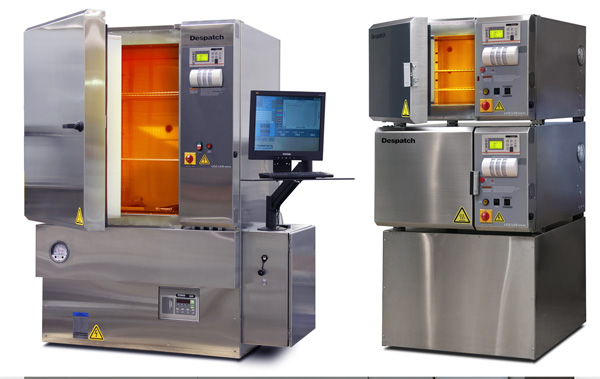Polyimide and Epoxy Curing Oven
![]() APPLICATION NOTE -
Polyimide and Epoxy cure
APPLICATION NOTE -
Polyimide and Epoxy cure
Polyimides are used primarily in the electronics and semiconductor industries for insulation, stress buffer coating, interlayer dielectric and in photo imaging. Polyimides have good thermal stability, chemical resistance, dielectric properties, and mechanical durability. Some are photo imageable, while others have suitable wet and dry etch characteristics for use in building up microelectronic structures on silicon wafers.
Polyimides and solvents are applied by spin coating and other methods and then require various levels of thermal processing depending upon the next step(s) in the process and the end goal of the design. A low temperature “soft bake” or “alpha cure” are typically used for initial removal of solvent at temperatures typically in the range of 100-to-150°C. “Beta cure”, post-exposure bake (PEB), and “hard bake” follow this initial cure and are used to remove residual solvent and finalize the desired surface properties. They typically come after UV exposure in photolithography at temperatures in the range from to as high as 350-to-400°C, depending upon the application and temperature limit of components in the “stack”. The temperature ramping rate is often limited to 5°C/min or less to avoid damaging the polyimide layer. Quite often polyimide curing is done at low oxygen concentrations either by means of nitrogen purging at atmospheric pressure or via a combination of nitrogen backfilling and vacuum. Oxygen levels lt 20ppm can be required. Low particulate concentrations are also necessary to avoid defects in the polyimide layer. Initial solvent removal may require special safety and solvent collection equipment inside or external to the thermal treatment equipment to avoid process, safety, and environmental problems. This may involve use of condensate traps, nitrogen purging at varying rates during the process, use of vacuum and HEPA filtration to avoid solvent condensation on the product, oven, exhaust lines, as well as ensuring that the polyimide layer retains uniform characteristics that are defect (i.e., contaminants, gas bubbles, delamination, cracks) free.
Despatch ovens are known and designed with higher volumes of airflow with unique distribution for exceptional temperature uniformity performance. We have equipment capable of reducing the oxygen content to less than 20 PPM. Our Clean Process ovens have capabilities of maintaining Class 100/ISO Class 5 conditions at up to 5°C heating and cooling rates as well as at stable conditions.


